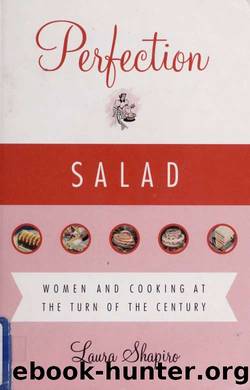Perfection salad : women and cooking at the turn of the century by Shapiro Laura

Author:Shapiro, Laura
Language: eng
Format: epub
Tags: History, Women's Studies - History, Cookery, Cooking / Wine, Sociology, Home economics, Cooking, Diet, Nutrition
Publisher: New York : North Point Press/Farrar, Straus, and Giroux
Published: 1995-09-14T16:00:00+00:00
to know that she can be just as happy if she must make one t^room answer the three purposes, and besides, being an American, she has this thought to comfort her, that under this glorious Government her thrift and economy may help to place her husband among the millionaires.”
While the chance to economize their way to aristocracy may indeed have comforted a few wives, the surest “antidote” to social and economic distinctions was the prominent example of a middle class. The ideal home life that was promoted by domestic scientists was defined not by wealth or even occupation but by correct habits and sensibilities. Certain signs of respectability were available to everyone, presumably, and when they were achieved they lent a uniform measure of dignity regardless of income. At the New York Cooking School, where separate courses were set up forJladies” and for the daughters of “artisans,” Juliet Corson used lo warn the students in the artisans’ course to pour the gravy carefully on the meat “without slopping it over the dish,” a nicety she felt no need to state in the ladies’ course. Cleanliness, order, decorum; a visible refinement; a cultivated intelligence—these features of what domestic scientists called “right living” comprised a standard of domesticity they hoped to instill everywhere in American society, although they were aware that some populations would require a more thorough overhaul than others. With scientific cookery as the chief means—as well as much of the goal—they hoped to regulate the messy sprawl of American society and to filter out the most unsettling aspects of its diversity. Writing in New England Kitchen Magazine, a visitor to a Georgia exposition described vvdth a tingle of horrified relish the typical dinner she was served by a cordial Southern hostess: “Turnips cooked with pork, green tops and all, beef roasted to a cinder, and coffee of Chattahoochian flavor. . . .” Virtually the only food she could swallow during her stay was served at a reception in the Woman’s Building of the exposition, where a domestic scientist from Boston was in charge of the menu. Bouillon in cups, “tiny crackers,” plates of chicken salad with olives and a single roll, and a green-and-
Download
This site does not store any files on its server. We only index and link to content provided by other sites. Please contact the content providers to delete copyright contents if any and email us, we'll remove relevant links or contents immediately.
100 Techniques: Master a Lifetime of Cooking Skills, From Basic to Bucket List by America's Test Kitchen(925)
Barefoot in Paris: Easy French Food You Can Make at Home by Ina Garten(816)
Eating Out Loud : Bold Middle Eastern Flavors for All Day, Every Day: a Cookbook (9780593135884) by Grinshpan Eden(777)
Wheat Belly by MD William Davis(766)
The Flavor Equation by Nik Sharma(761)
The Curry Guy Thai by Dan Toombs(749)
Dumplings and Noodles by Pippa Middlehurst(743)
To Asia, With Love by Hetty McKinnon(738)
MasterChef the Classics with a Twist by MasterChef(695)
A Blissful Feast by 449943184(686)
Baking by Dorie Greenspan(680)
Fix-It and Forget-It Mediterranean Diet Cookbook by Hope Comerford(678)
Gordon Ramsay Quick and Delicious: 100 Recipes to Cook in 30 Minutes or Less by Gordon Ramsay(677)
Betty Crocker Kids Cook (Betty Crocker Cooking) by Betty Crocker(652)
Food on the go: Sumptuous Food Truck Recipes by Heston Brown(642)
The World Cookbook by Jeanne Jacob-Ashkenazi(621)
Bon Appetit, Y'all: Recipes and Stories From Three Generations of Southern Cooking by Virginia Willis; Ellen Silverman(620)
The Chopped Cookbook: Use What You've Got to Cook Something Great by Food Network Kitchen(590)
The Soup Cookbook : 100 Best Recipes by Michelle Smith(584)
